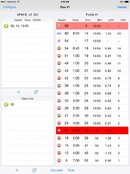You are using an out of date browser. It may not display this or other websites correctly.
You should upgrade or use an alternative browser.
You should upgrade or use an alternative browser.
ICD and switch to nx38 from normoxic trimix
- Thread starter Subcooled
- Start date
Please register or login
Welcome to ScubaBoard, the world's largest scuba diving community. Registration is not required to read the forums, but we encourage you to join. Joining has its benefits and enables you to participate in the discussions.
Benefits of registering include
- Ability to post and comment on topics and discussions.
- A Free photo gallery to share your dive photos with the world.
- You can make this box go away
PfcAJ
Contributor
If the computer says it then it MUST be true?
waterpirate
Contributor
I do not do the dives that I think IBCD would ever be an issue. I seriously doubt if any forray to 45 meters would be either. While this discussion has been interesting, the point missed is the big experiment. It is allways our own bodies, our instrument. Learning to listen to it and predict results is a finer point overlooked in classes. I opt for helium in my deco mixes not to combat IBCD, but to mitigate narcosis. A bad case of the spins at 130fsw in fla. 3 years ago after the gas switch promted my decision. I also routinely feed my body helitrox, sooo I tune my instrument with what it is used to getting, predictable results.
YMMV
Eric
YMMV
Eric
Ummm... the OP did say it was a NORMOXIC trimix, so I don't see that this is particularly germane to the discussion...
Unless there's some debate on if a 15% O2 is a good idea on an 80 foot dive?
PfcAJ
Contributor
I think that table is in meters.
ajduplessis
Contributor
If the computer says it then it MUST be true?
These are guidelines/safety tolerances and yes they differ from one person to another. In diving there is no hard and fast. Divers have died staying within staying "safe" limits and other still dive while exceeding the safe limits.
YOU know this better than most around here.
PfcAJ
Contributor
Once again, despite a computer warning people aren't getting bent doing switches to 50% from 15/55.
Im interested in real life.
Im interested in real life.
It looks like the Suunto dive planner and V-Planner would use some percentage-only rule for ICD warnings, and would not take into account the amount of dissolved gas and other parameters. Am I correct?
I would assume that tissue compartment helium and nitrogen loadings, the ambient pressure, amount of supersaturation, the percentages of the new gas, and amount of perfusion would all affect this phenomenon in a complicated way. Am I correct? Surely it cannot be easier to model than ordinary offgassing.
Are there any dive planners in existence that attempt to model this properly, physically and statistically? Are there any mathematical ICD models in existence, with experimentally found parameters?
Ignoring oxygen clocks and stuff, I would guess that spending five hours at 45m on trimix 21% 02, 35% He, and then switching to EAN40 might be a problem (again, I might be wrong). Half an hour is not. I know it now.
An instructor shortly explained to me some rules of thumb relating to ICD, that I have now forgotten, went on to declare it irrelevant to me, and didn't explain the phenomenon (insert warm fuzzy feeling here). Such is the quality of recreational dive instruction. Recreational as in not commercial.
I would assume that tissue compartment helium and nitrogen loadings, the ambient pressure, amount of supersaturation, the percentages of the new gas, and amount of perfusion would all affect this phenomenon in a complicated way. Am I correct? Surely it cannot be easier to model than ordinary offgassing.
Are there any dive planners in existence that attempt to model this properly, physically and statistically? Are there any mathematical ICD models in existence, with experimentally found parameters?
Ignoring oxygen clocks and stuff, I would guess that spending five hours at 45m on trimix 21% 02, 35% He, and then switching to EAN40 might be a problem (again, I might be wrong). Half an hour is not. I know it now.
An instructor shortly explained to me some rules of thumb relating to ICD, that I have now forgotten, went on to declare it irrelevant to me, and didn't explain the phenomenon (insert warm fuzzy feeling here). Such is the quality of recreational dive instruction. Recreational as in not commercial.
Last edited:
ajduplessis
Contributor
Divers also die/get bent without any computer warnings. Real life enough for you? You have been around the block a couple of times. Every lost a buddy within safe limits? Ever lost a buddy exceeding limits?
PfcAJ
Contributor
...they're not getting inner ear dcs from switching to 50% from 15/55... Sorry bro but that's a routine thing.
Similar threads
- Replies
- 11
- Views
- 834
- Replies
- 83
- Views
- 7,417
- Replies
- 67
- Views
- 5,501





